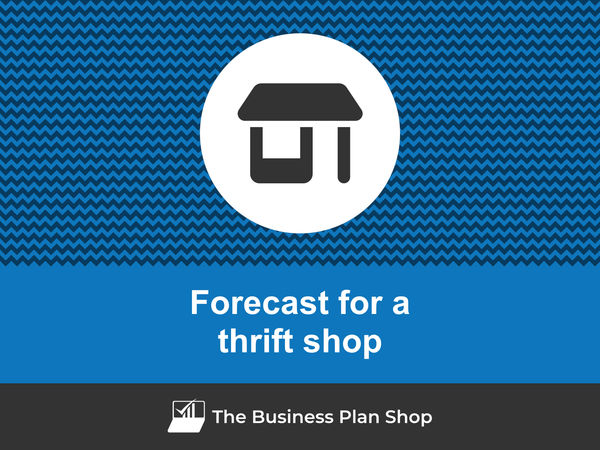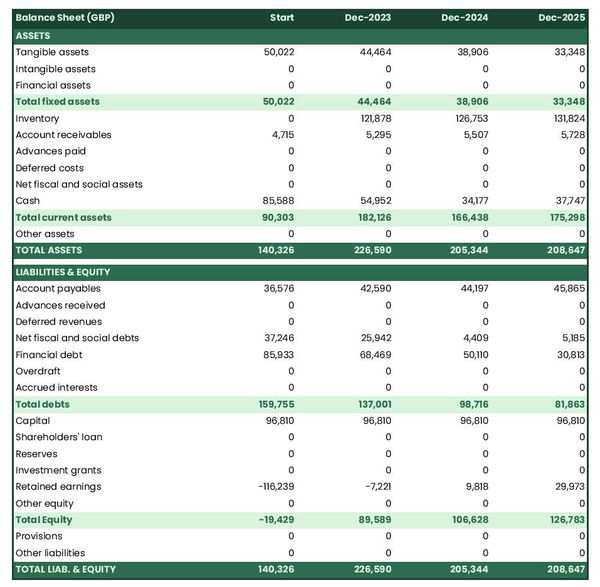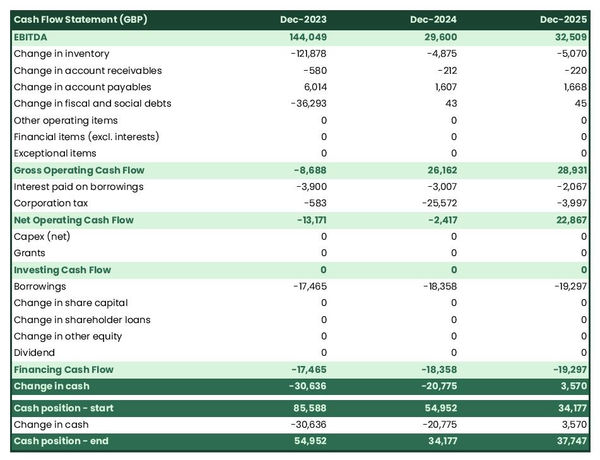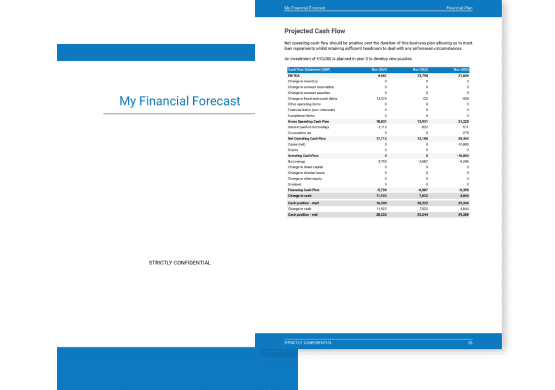How to create a financial forecast for a thrift shop?

If you are serious about keeping visibility on your future cash flows, then you need to build and maintain a financial forecast for your thrift shop.
Putting together a thrift shop financial forecast may sound complex, but don’t worry, with the right tool, it’s easier than it looks, and The Business Plan Shop is here to guide you.
In this practical guide, we'll cover everything you need to know about building financial projections for your thrift shop.
We will start by looking at why they are key, what information is needed, what a forecast looks like once completed, and what solutions you can use to create yours.
Let's dive in!
Why create and maintain a financial forecast for a thrift shop?
In order to prosper, your business needs to have visibility on what lies ahead and the right financial resources to grow. This is where having a financial forecast for your thrift shop becomes handy.
Creating a thrift shop financial forecast forces you to take stock of where your business stands and where you want it to go.
Once you have clarity on the destination, you will need to draw up a plan to get there and assess what it means in terms of future profitability and cash flows for your thrift shop.
Having this clear plan in place will give you the confidence needed to move forward with your business’s development.
Having an up-to-date financial forecast for a thrift shop is also useful if your trading environment worsens, as the forecast enables you to adjust to your new market conditions and anticipate any potential cash shortfall.
Finally, your thrift shop's financial projections will also help you secure financing, as banks and investors alike will want to see accurate projections before agreeing to finance your business.
Need a solid financial forecast?
The Business Plan Shop does the maths for you. Simply enter your revenues, costs and investments. Click save and our online tool builds a three-way forecast for you instantly.

What information is used as input to build a thrift shop financial forecast?
A thrift shop's financial forecast is only as good as the inputs used to build it.
If you are creating (or updating) the forecast of an existing thrift shop, then you mostly need your accounting information, key historical operating non-financial data, and your team’s input on what to expect for the coming years.
If you are building financial projections for a thrift shop startup, you will need to have done your research and have a clear picture of your competitive environment and go-to-market strategy so that you can forecast sales accurately.
For a new venture, you will also need a precise list of the resources needed to keep the thrift shop running on a day-to-day basis and a list of the equipment and expenditures required to start the business (more on that later).
Let's now take a closer look at the elements that make up your thrift shop's financial forecast.
The sales forecast for a thrift shop
The sales forecast, also called topline projection, is normally where you will start when building your thrift shop financial forecast.
Creating a coherent sales projection boils down to estimating two key drivers:
- The average price
- The number of monthly transactions
To do this, you will need to rely on historical data (for an existing business), market research data (for both new and existing thrift shops), and consider the elements below:
- Seasonal Trends: As a thrift shop owner, you know that certain times of the year are busier than others. For example, during the summer months, you may see an increase in sales as people clean out their closets and donate more items. On the other hand, sales may slow down during the holiday season as people focus on buying gifts instead of shopping for secondhand items.
- Economy: The state of the economy can greatly affect the average price and number of monthly transactions in your thrift shop. During times of economic downturn, people are more likely to shop at thrift stores in order to save money. However, during times of economic prosperity, people may be more willing to spend money on new items, which could lead to a decrease in sales.
- Donation Trends: The amount and type of donations your thrift shop receives can also impact your average price and number of transactions. For example, if you receive a large donation of high-quality, desirable items, you may see an increase in average price and sales as customers are willing to pay more for these items. On the other hand, if you receive a lot of low-quality or outdated donations, it may be more challenging to sell them at a higher price, leading to a decrease in average price and sales.
- Competition: Your thrift shop may face competition from other secondhand stores in the area. If there are a lot of thrift stores nearby, it may be more difficult to attract customers and maintain sales. On the other hand, if your thrift shop is the only one in the area, you may see an increase in sales as customers have limited options for secondhand shopping.
- Trends and Popularity: The popularity of thrift shopping can also impact your sales forecast. If thrift shopping becomes a popular trend or there is a growing demand for sustainable and eco-friendly shopping options, you may see an increase in sales. On the other hand, if thrift shopping falls out of trend, it may lead to a decline in sales.
After the sales forecast comes the operating expenses budget, which we will now look into in more detail.
Need inspiration for your business plan?
The Business Plan Shop has dozens of business plan templates that you can use to get a clear idea of what a complete business plan looks like.

The operating expenses for a thrift shop
The next step is to estimate the costs you’ll have to incur to operate your thrift shop.
These will vary based on where your business is located, and its overall size (level of sales, personnel, etc.).
But your thrift shop's operating expenses should normally include the following items:
- Staff Costs: This includes wages, salaries, and benefits for all employees working in the thrift shop, such as cashiers, store managers, and donation coordinators.
- Rent or Lease Expenses: You will need to pay rent or lease expenses for the space that your thrift shop operates in.
- Utilities: This includes electricity, water, and gas expenses for your thrift shop.
- Inventory Costs: You will need to purchase inventory, such as clothing, furniture, and household items, to sell in your thrift shop.
- Marketing and Advertising: You may need to spend money on marketing and advertising to promote your thrift shop and attract customers.
- Accountancy Fees: You may need to hire an accountant or use accounting software to manage your finances and file taxes for your thrift shop.
- Insurance Costs: You will need to purchase insurance to protect your thrift shop from potential risks, such as theft, fire, or liability.
- Software Licenses: You may need to purchase software licenses for tools that help you manage your thrift shop, such as point-of-sale systems or inventory management software.
- Banking Fees: You may need to pay fees for banking services, such as processing credit card transactions or depositing cash into your thrift shop's account.
- Maintenance and Repairs: You may need to spend money on maintaining and repairing your thrift shop's equipment, such as cash registers, shelving, and lighting fixtures.
- Cleaning and Janitorial Services: You may need to hire a cleaning service to keep your thrift shop clean and presentable for customers.
- Transportation Expenses: You may need to spend money on transportation, such as gas and vehicle maintenance, to pick up donations and transport inventory to your thrift shop.
- Training and Development: You may need to invest in training and development programs for your employees to improve their skills and job performance.
- Office Supplies: You may need to purchase office supplies, such as paper, ink, and pens, to keep your thrift shop running smoothly.
- Telephone and Internet Expenses: You may need to pay for telephone and internet services to communicate with customers, suppliers, and other businesses.
This list is not exhaustive by any means, and will need to be tailored to your thrift shop's specific circumstances.
What investments are needed to start or grow a thrift shop?
Once you have an idea of how much sales you could achieve and what it will cost to run your thrift shop, it is time to look into the equipment required to launch or expand the activity.
For a thrift shop, capital expenditures and initial working capital items could include:
- Inventory - This includes the initial purchase of items to be sold in the thrift shop, as well as ongoing purchases to replenish inventory.
- Point of Sale System - A quality point of sale system is essential for tracking sales, managing inventory, and analyzing data. This is a necessary and valuable investment for a thrift shop.
- Store Fixtures and Displays - These are the physical elements that make up the layout and design of the thrift shop, including shelves, racks, and display cases. These items are necessary for organizing merchandise and creating an attractive shopping experience for customers.
- Security System - To protect the thrift shop from theft and vandalism, investing in a security system is important. This may include cameras, alarms, or other measures to secure the physical store and its contents.
- Delivery Vehicle - If the thrift shop offers pick-up or delivery services for larger items, investing in a reliable delivery vehicle can be beneficial. This will allow for efficient and timely transportation of merchandise, enhancing the customer experience and potentially increasing sales.
Again, this list will need to be adjusted according to the specificities of your thrift shop.
Need a convincing business plan?
The Business Plan Shop makes it easy to create a financial forecast to assess the potential profitability of your projects, and write a business plan that’ll wow investors.

The financing plan of your thrift shop
The next step in the creation of your financial forecast for your thrift shop is to think about how you might finance your business.
You will have to assess how much capital will come from shareholders (equity) and how much can be secured through banks.
Bank loans will have to be modelled so that you can separate the interest expenses from the repayments of principal, and include all this data in your forecast.
Issuing share capital and obtaining a bank loan are two of the most common ways that entrepreneurs finance their businesses.
What tables compose the financial plan for a thrift shop?
Now let's have a look at the main output tables of your thrift shop's financial forecast.
The projected profit & loss statement
The projected profit & loss shows how profitable your thrift shop is likely to be in the years to come.

For your thrift shop to be financially viable, your projected P&L should ideally show:
- Sales growing above inflation (the higher the better)
- Profit margins which are stable or expanding (the higher the better)
- A net profit at the end of each financial year (the higher the better)
This is for established thrift shops, there is some leniency for startups which will have numbers that will look a bit different than existing businesses.
The projected balance sheet
Your thrift shop's forecasted balance sheet enables you to assess your financial structure and working capital requirements.
It is composed of three types of elements: assets, liabilities and equity:
- Assets: represent what the business owns and uses to produce cash flows. It includes resources such as cash, equipment, and accounts receivable (money owed by clients).
- Liabilities: represent funds advanced to the business by lenders and other creditors. It includes items such as accounts payable (money owed to suppliers), taxes due and loans.
- Equity: is the combination of what has been invested by the business owners and the cumulative profits and losses generated by the business to date (which are called retained earnings). Equity is a proxy for the value of the owner's stake in the business.

The cash flow forecast
Your thrift shop's cash flow forecast shows how much cash your business is expected to consume or generate in the years to come.

It is best practice to organise the cash flow forecast by nature to better explain where cash is used or generated by the thrift shop:
- Operating cash flow: shows how much cash is generated by the operating activities
- Investing cash flow: shows how much will be invested in capital expenditure to maintain or expand the business
- Financing cash flow: shows if the business is raising new capital or repaying financiers (debt repayment, dividends)
Keeping an eye on (and regularly updating) your thrift shop's cash flow forecast is key to ensuring that your business has sufficient liquidity to operate normally and to detect financing requirements as early as possible.
If you are trying to raise capital, you will normally be asked to provide a monthly cash flow forecast in your thrift shop's financial plan - so that banks or investors can assess seasonal variation and ensure your business is appropriately capitalised.
Need a solid financial forecast?
The Business Plan Shop does the maths for you. Simply enter your revenues, costs and investments. Click save and our online tool builds a three-way forecast for you instantly.

Which tool should you use to create your thrift shop's financial forecast?
Creating your thrift shop's financial forecast may sound fairly daunting, but the good news is that there are several ways to go about it.
Using online financial forecasting software to build your thrift shop's projections
The modern and easiest way is to use an online financial forecasting tool such as the one we offer at The Business Plan Shop.
There are several advantages to using specialised software:
- You can easily create your financial forecast by letting the software take care of the financial calculations for you without errors
- You have access to complete financial forecast templates
- You get a complete financial forecast ready to be sent to your bank or investors
- You can easily track your actual financial performance against your financial forecast, and recalibrate your forecast as the year goes by
- You can create scenarios to stress test your forecast's main assumptions
- You can easily update your forecast as time goes by to maintain visibility on future cash flows
- You have a friendly support team on standby to assist you when you are stuck
- It’s cost-efficient and much cheaper than using an accountant or consultant (see below)
If you are interested in this type of solution, you can try our projection software for free by signing up here.
Hiring a financial consultant or chartered accountant
Hiring a consultant or chartered accountant is also an efficient way to get a professional thrift shop financial projection.
As you can imagine, this solution is much more expensive than using software. From experience, the creation of a simple financial forecast over three years (including a balance sheet, income statement, and cash flow statement) is likely to start around £700 or $1,000 excluding taxes.
The indicative estimate above, is for a small business, and a forecast done as a one-off. Using a financial consultant or accountant to track your actuals vs. forecast and to keep your financial forecast up to date on a monthly or quarterly basis will naturally cost a lot more.
If you choose this solution, make sure your service provider has first-hand experience in your industry, so that they may challenge your assumptions and offer insights (as opposed to just taking your figures at face value to create the forecast’s financial statements).
Why not use a spreadsheet such as Excel or Google Sheets to build your thrift shop's financial forecast?
You and your financial partners need numbers you can trust. Unless you have studied finance or accounting, creating a trustworthy and error-free thrift shop financial forecast on a spreadsheet is likely to prove challenging.
Financial modelling is very technical by nature and requires a solid grasp of accounting principles to be done without errors. This means that using spreadsheet software like Excel or Google Sheets to create accurate financial forecasts is out of reach for most business owners.
Creating forecasts in Excel is also inefficient nowadays:
- Software has advanced to the point where forecasting can be done much faster and more accurately than manually on a spreadsheet.
- With artificial intelligence, the software is capable of detecting mistakes and helping decision-making.
Spreadsheets are versatile tools but they are not tailor-made for reporting. Importing your thrift shop's accounting data in Excel to track actual vs. forecast is incredibly manual and tedious (and so is keeping forecasts up to date). It is much faster to use dedicated financial planning tools like The Business Plan Shop which are built specially for this.
Need a convincing business plan?
The Business Plan Shop makes it easy to create a financial forecast to assess the potential profitability of your projects, and write a business plan that’ll wow investors.

Use our financial projection templates for inspiration
The Business Plan Shop has dozens of financial forecasting templates available.
Our examples contain both the financial forecast, and a written business plan which presents, in detail, the company, the team, the strategy, and the medium-term objectives.
Whether you are just starting out or already have your own thrift shop, looking at our template is always a good way to get ideas on how to model financial items and what to write when creating a business plan to secure funding.

Takeaways
- A financial forecast shows expected growth, profitability, and cash generation metrics for your thrift shop.
- Tracking actuals vs. forecast and having an up-to-date financial forecast is key to maintaining visibility on your future cash flows.
- Using financial forecasting software is the modern way of creating and maintaining financial projections.
We hope that this guide helped you gain a clearer perspective on the steps needed to create the financial forecast for a thrift shop. Don't hesitate to contact us if you have any questions!
Need inspiration for your business plan?
The Business Plan Shop has dozens of business plan templates that you can use to get a clear idea of what a complete business plan looks like.

Also on The Business Plan Shop
Know someone who runs a thrift shop? Share our business guide with them!







